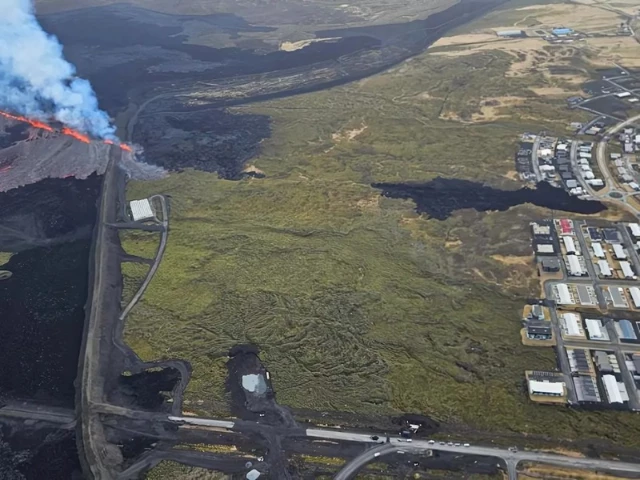Iceland’s Grindavík evacuated as volcanic eruption threatens village
Lava breaches barriers, forcing officials to evacuate residents from Grindavík, Iceland.

Lava fountains and billowing smoke poured from a volcanic fissure in Iceland on Tuesday, as officials desperately worked to evacuate the remaining residents of the mostly abandoned fishing village of Grindavík.
The eruption, which began at 9:45 AM local time (12:45 PM Pakistan Standard Time), quickly breached protective barriers made from car-sized boulders that had been constructed to shield the village from molten rock.
Earlier, emergency services successfully evacuated tourists from the nearby Blue Lagoon luxury spa as geologists and a pre-dawn earthquake signaled the impending eruption. However, despite the warnings, some residents of Grindavík, located about 40 kilometers southwest of Reykjavik, initially refused to leave their homes.
"I have 50 people involved in this operation, some of whom are volunteers," said South Iceland police commissioner Ulfar Luoviksson, urging residents to show more consideration for the civil defense efforts. "Those who choose to remain in the town don't seem to realize the gravity of the situation."
By noon on Tuesday (3:00 PM PST), just hours after the eruption began, authorities had successfully evacuated all residents, declaring the village empty. Grindavík, which had been home to 4,000 residents, has seen most of its population leave since 2023 due to the growing risks from volcanic activity. Around 40 homes were still occupied, but authorities were able to clear the area swiftly.
The volcanic fissure, now more than a kilometer long, opened up between the defensive barriers and the village, with a second fissure forming shortly afterward. Iceland's government had built these protective barriers in 2023 after the region's geological activity reactivated, following 800 years of dormancy.
This eruption is the latest in a series of 11 eruptions in the area since 2021. While this eruption is not as disruptive as the infamous 2010 Eyjafjallajökull eruption, which grounded flights across the Atlantic for months, authorities warned that the situation remains unstable.
The Icelandic Meteorological Office cautioned that although no new seismic activity was observed, the event is far from over.
Experts predict that these fissure eruptions could continue for decades, if not centuries, raising concerns about the long-term safety of the region. Iceland, located on the Mid-Atlantic Ridge where the North American and Eurasian tectonic plates meet, is no stranger to seismic activity, but the ongoing volcanic threat in Grindavík highlights the vulnerability of the small island nation.






















COMMENTS
Comments are moderated and generally will be posted if they are on-topic and not abusive.
For more information, please see our Comments FAQ